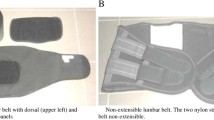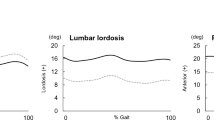Abstract
Spinal orthoses are implemented to restrict lumbar motion. Several studies have compared the effectiveness of various types of lumbar orthoses on restricting motion, but none have compared the effect of different back supports on restricting extension. This study sought to evaluate the effectiveness of three types of lumbar orthosis in regard to their ability to restrict motion during extension. Range of motion was quantified using the Spinal Mouse system to measure flexion and extension, and the load distribution of the back support was measured using a pressure sensor. Ten subjects (8 men, 2 women) were assessed under the following five experimental conditions: custom-made stay (CMS), aluminum stay (AS), plastic stay (PS), corset only, and no brace. None of the stays changed the flexion angle, and none of the supports prevented flexion bending. The mean extension angle after immobilization with the CMS, AS, PS, corset only, and no brace was 27.5° ± 8.5°, 33.4° ± 11.0°, 34.3° ± 9.4°, 37.8° ± 10.7°, and 42.6° ± 10.5°, respectively. The load in the CMS was concentrated at the vertical ends of the stay, with a mean load of 11.5 ± 2.4 N at the top and 8.9 ± 2.4 N at the bottom. The loads at the top and bottom of the support were 7.2 ± 4.3 and 5.3 ± 3.1 N with the AS and 5.8 ± 2.3 and 4.4 ± 1.7 N with the PS, respectively. All supports allowed similar flexion motion. Although the CMS, AS, and PS all restricted extension compared with no brace, the CMS was the most effective for restricting trunk extension motion.




Similar content being viewed by others
References
Micheli LJ (1979) Low back pain in the adolescent: differential diagnosis. Am J Sports Med 7(6):362–364
Bono CM (2004) Low-back pain in athletes. J Bone Joint Surg Am 86A(2):382–396
Standaert CJ, Herring SA, Halpern B, King O (2000) Spondylolysis. Phys Med Rehabil Clin N Am 11(4):785–803
Iwamoto J, Takeda T, Wakano K (2004) Returning athletes with severe low back pain and spondylolysis to original sporting activities with conservative treatment. Scand J Med Sci Sports 14(6):346–351
d’Hemecourt PA, Zurakowski D, Kriemler S, Micheli LJ (2002) Spondylolysis: returning the athlete to sports participation with brace treatment. Orthopedics 25(6):653–657
Buchalter D, Parnianpour M, Viola K, Nordin M, Kahanovitz N (1988) Three-dimensional spinal motion measurements. Part 1: a technique for examining posture and functional spinal motion. J Spinal Disord 1(4):279–283
Buchalter D, Kahanovitz N, Viola K, Dorsky S, Nordin M (1988) Three-dimensional spinal motion measurements. Part 2: a noninvasive assessment of lumbar brace immobilization of the spine. J Spinal Disord 1(4):284–286
Fidler MW, Plasmans CM (1983) The effect of four types of support on the segmental mobility of the lumbosacral spine. J Bone Joint Surg Am 65(7):943–947
Jegede KA, Miller CP, Bible JE, Whang PG, Grauer JN (2011) The effects of three different types of orthoses on the range of motion of the lumbar spine during 15 activities of daily living. Spine 36(26):2346–2353
Krag MH, Fox MSJ, Haugh LD (2003) Comparison of three lumbar orthoses using motion assessment during task performance. Spine 28(20):2359–2367
Lantz SA, Schultz AB, Lumbar spine orthosis wearing. I (1986) Restriction of gross body motions. Spine 11(8):834–837
Axelsson P, Johnsson R, Strömqvist B (1992) Effect of lumbar orthosis on intervertebral mobility. A roentgen stereophotogrammetric analysis. Spine 17(6):678–681
Axelsson P, Johnsson R, Strömqvist B (1993) Lumbar orthosis with unilateral hip immobilization. Effect on intervertebral mobility determined by roentgen stereophotogrammetric analysis. Spine 18(7):876–879
Lumsden RM, Morris JM (1968) An in vivo study of axial rotation and immobilization at the lumbosacral joint. J Bone Joint Surg Am 50(8):1591–1602
Willems PC, Nienhuis B, Sietsma M, van der Schaaf DB, Pavlov PW (1997) The effect of a plaster cast on lumbosacral joint motion. An in vivo assessment with precision motion analysis system. Spine 22(11):1229–1234
Hashimoto K, Miyamoto K, Yanagawa T, Hattori R, Aoki T, Matsuoka T, Ohno T, Shimizu K (2013) Lumbar corsets can decrease lumbar motion in golf swing. J Sports Sci Med 12(1):80–87
Sakai T, Sairyo K, Takao S, Nishitani H, Yasui N (2009) Incidence of lumbar spondylolysis in the general population in Japan based on multidetector computed tomography scans from two thousand subjects. Spine 34(21):2346–2350
Morita T, Ikata T, Katoh S, Miyake R (1995) Lumbar spondylolysis in children and adolescents. J Bone Joint Surg Br 77(4):620–625
Sairyo K, Sakai T, Yasui N (2009) Conservative treatment of lumbar spondylolysis in childhood and adolescence: the radiological signs which predict healing. J Bone Joint Surg Br 91(2):206–209
Sairyo K, Sakai T, Yasui N, Dezawa A (2012) Conservative treatment for pediatric lumbar spondylolysis to achieve bone healing using a hard brace: what type and how long? Clinical article. J Neurosurg Spine 16(6):610–614
Steiner ME, Micheli LJ (1985) Treatment of symptomatic spondylolysis and spondylolisthesis with the modified Boston brace. Spine 10(10):937–943
Muschik M, Hähnel H, Robinson PN, Perka C, Muschik C (1996) Competitive sports and the progression of spondylolisthesis. J Pediatr Orthop 16(3):364–369
Sairyo K, Katoh S, Sasa T, Yasui N, Goel VK, Vadapalli S, Masuda A, Biyani A, Ebraheim N (2005) Athletes with unilateral spondylolysis are at risk of stress fracture at the contralateral pedicle and pars interarticularis: a clinical and biomechanical study. Am J Sports Med 33:583–590
Terai T, Sairyo K, Goel VK, Ebraheim N, Biyani A, Faizan A, Sakai T, Yasui N (2010) Spondylolysis originates in the ventral aspect of the pars interarticularis: a clinical and biomechanical study. J Bone Joint Surg Br 92(8):1123–1127
Terai T, Sairyo K, Goel VK, Ebraheim N, Biyani A, Ahmad F, Kiapour A, Higashino K, Sakai T, Yasui N (2011) Biomechanical rationale of sacral rounding deformity in pediatric spondylolisthesis: a clinical and biomechanical study. Arch Orthop Trauma Surg 131(9):1187–1194
Perry J (1970) The use of external support in the treatment of low-back pain. Report of the Subcommittee on Orthotics of the Committee on Prosthetic-Orthotic Education, National Academy of Sciences, National Research Council. J Bone Joint Surg Am 52(7):1440–1442
Acknowledgments
The authors thank Dr. Daisuke Hamada for providing technical advice on statistical analysis.
Conflict of interest
No funds were received in support of this study.
Author information
Authors and Affiliations
Corresponding author
Rights and permissions
About this article
Cite this article
Terai, T., Yamada, H., Asano, K. et al. Effectiveness of three types of lumbar orthosis for restricting extension motion. Eur J Orthop Surg Traumatol 24 (Suppl 1), 239–243 (2014). https://doi.org/10.1007/s00590-014-1446-8
Received:
Accepted:
Published:
Issue Date:
DOI: https://doi.org/10.1007/s00590-014-1446-8




